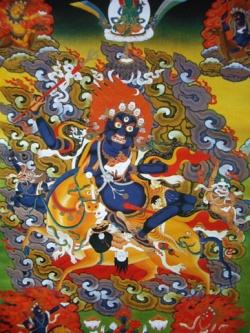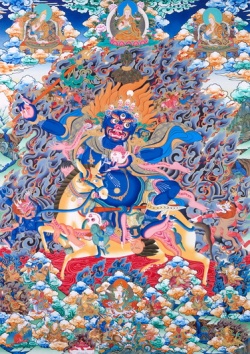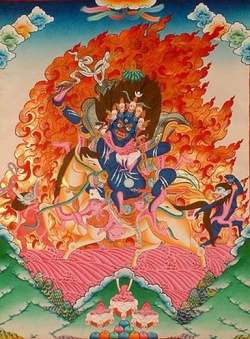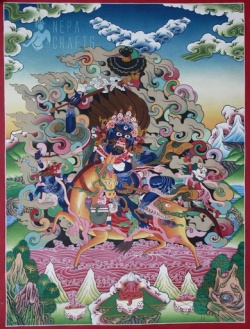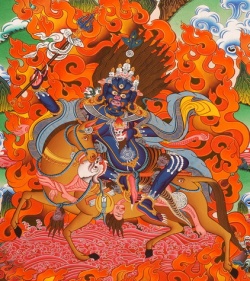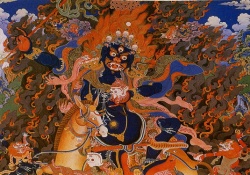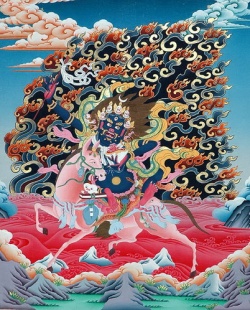Palden Lhamo
Palden Lhamo (pronounced: 'Pelden Lhamo'), Palden Lamo (Tibetan: དཔལ་ལྡན་ལྷ་མོ།, Wylie: dpa ldan lha mo; Shri Devi (Sanskrit), Ukin Tengri (Mongolian), or Remati is a protecting Dharmapala of the teachings of Gautama Buddha in the Gelug school of Tibetan Buddhism.
She is the wrathful deity considered to be the principal Protectress of Tibet.
Palden Lhamo is the consort of Mahakala and has been described as "the tutelary deity of Tibet and its government", and as "celebrated all over Tibet and Mongolia, and the potent protector of the Dalai and Panchen Lamas and Lhasa.
Shri Devi is a category of Tantric Buddhist deity.
Her primary function is as a protector (Dharmapala) and specifically the primary female Wisdom Protector of Himalayan and Tibetan Buddhism.
There are dozens of different variations and forms of Shri Devi.
She is typically in wrathful appearance following the Indian model of a Rakshasi demon.
In most occurrences and uses of Shri Devi, but not all, she is paired with a specific form of Mahakala.
Aside from the individual Anuttarayoga Tantras that teach various forms of Shri Devi, the principal texts are the Twenty-five and Fifty Chapter Mahakala Tantras.
The textual source for Magzor Gyalmo is the Dakinyagnijihajvala Tantra, Dege Kanjur, volume 98, pp.223-253.
It is found in the Nyingma Tantra section, vol.3. TBRC w22084.
Shri Devi is not one entity or personality.
Depending on the form of Shri Devi she could be a wrathful emanation of a number of different deities such as Shri Devi Magzor Gyalmo is the wrathful form of Sarasvati.
Some forms of Shri Devi with four arms such as Dudusolma are the wrathful form of Shri Lakshmi (Pal Lhamo).
Palden Lhamo and the lake Lhamo La-tso
It is said that Palden Lhamo, as the female guardian spirit of the sacred lake, Lhamo La-tso, promised Gendun Drup, the 1st Dalai Lama in one of his visions "that she would protect the reincarnation lineage of the Dalai Lamas.
" Ever since the time of Gendun Gyatso, the 2nd Dalai Lama, who formalised the system, the Regents and other monks have gone to the lake to seek guidance on choosing the next reincarnation through visions while meditating there.
The particular form of Palden Lhamo at the lake Lhamo La-tso is Gyelmo Maksorma,
"The Victorious One who Turns Back Enemies".
The lake is sometimes referred to as "Pelden Lhamo Kalideva", which indicates that Palden Lhamo is an emanation of the goddess Kali, the shakti of the Hindu god Siva.
Gyelmo Maksorma (rGyal mo dMag zor ma) or Machik Pelha Shiwai Nyamchen (Ma gcig dPal lh Zhi ba'i nyams can) is an unusually peaceful form of Palden Lhamo.
The mountain to the south of Chokorgyel Monastery, Shridevi, is the "blu residence of the Protectress Palden Lhamo on which a dundro or sky burial site is located.
The monastery was originally built in a triangular form to reflect the symbolism of its position at the confluence of three rivers and surrounded by three mountains and also represents the conjunction of the three elements of water, earth and fire, as well as the female principle of Palden Lhamo in the form of an inverted triangle.
Traditional accounts
It is said that, during the reign of Songtsen Gampo (605 or 617? – 649), Palden Lhamo outdid all the other protector-deities in her promise to protect the king's Trulang shrine.
She presented an iron cup and pledged "Erect an image of me, and I shall protect this royal shrine from any future damage by humans and mamo demons!'
She is also said to have advised Lhalung Pelgyi Dorje to kill the anti-Buddhist king Langdarma in 841 CE, and is described as the 'Dharma-protectress of Lhasa'.
Description.
Palden Lhamo (whose name translates as "Glorious Goddess") is the only female dharma protector common to all four schools of Tibetan Buddhism.
She is very wrathful, and rides her mule through a sea of blood, surrounded by wisdom fire.
She is dark blue and has one face with three eyes; she wears a sun at her navel and a moon at her crown, and over her is a peacock umbrella (a traditional symbol of protection).
She is variously depicted, but her most common forms are two-armed and four-armed.
There is also a system of divination by dice associated with her.
She is sometimes considered cognate to Sarasvati or Tara, but is at the same time a wrathful form of the peaceful goddess Sri Devi.
She is the only female among the traditional 'Eight Guardians of the Law' and is usually depicted as deep blue in colour and with red hair to symbolize her wrathful nature, crossing a sea of blood riding side-saddle on a white mule.
The mule has an eye on its left rump where her angry husband's arrow hit it after she killed her son (who was destined, and being raised to be the one to finally put an end to Buddhism) and used his skin as a saddle blanket.
She has three eyes and is often shown drinking blood from a human skull.
Palden Lhamo, the dark blue protector and only female among the Eight Guardians of the Law, is also Mahakali.
Sanskrit name Shri Devi means Great Lady, ie. [[Lady []]; Okkin Tungri to northern Mongolians.
Her name is often pronounced Penden Hamo.
One of the 5 Tseringma or Long-life Sisters and consort of Mahakala, she is Magzor Gyalmo -- Queen of Armies -- and is also considered a wrathful emanation of Saraswati.
She is usually depicted in nakthang black-ground style scroll crossing the sea of blood riding side-saddle on a white mule.
There is an eye on the left rump of the mule which is the place where her irate husband's arrow found a mark.
She had killed her son and used his flayed skin as a saddle blanket.
In many monasteries her image is in a corner and is always kept covered.
Lhamo (Skt. Kaladevi,) also called Remati, was married to Shinje, the king of the dudpos, who at the time of their marriage was the king of Lanka.
She had vowed either to gentle him and make him favourable towards the religion of Buddha, or else to see to it that an end be put to that whole dynasty.
Hard as she tried over many years, she could not effect any improvement in his evil ways and so she determined to kill their son who was being raised to be the one to finally do away with Buddhism in that kingdom.
During the king's absence, Devi accomplished the dreadful dead.
She killed her son and flayed him, then drank his blood using his skull for a cup and also ate his flesh.
She then left the palace and using her son's skin as a saddle cloth, set off for her northern home on one of the king's finest steeds.
On his return, seeing what had happened, the king seized his bow and with a fierce and terrible curse shot off a poisoned arrow, but the arrow only pierced the animal's rump and there it stuck fast.
The queen easily neutralized the king's imprecation, and removing the deadly barb she said:
"May the wound of my mount become an eye large enough to watch over the twenty-four regions, and may I myself be the one to extirpate the lineage of the malignant kings of Lanka!"
Then Palden Lhamo continued northwards, easily traversing India, Tíbet, Mongolia, and part of China, and finally settled, say some people, on the mountain Oikhan, in the Olgon district of Eastern Siberia.
This mountain is said to be surrounded by large, uninhabited deserts, and by the ocean Muliding.
Palden Lhamo is terrifying in aspect in order that she may better fight evil or negative forces, and enemies of the Buddhist teachings She rides a wild, white mule across the sea of blood; the flayed skin of her son, an enemy of Buddhism, serves as her saddle blanket.
The single eye on the rump of the mule was formed when Lhamo removed the arrow that her husband, the cannibal king of Sri Lanka and an enemy of the Buddhist doctrine, shot at her as she escaped him.
The trappings of the mule are made of snakes and from them hang many of Palden Lhamo's tools:
a pair of dice for divination, a stack of red tablets, a ball of magic thread, and a skin bag full of diseases with which she destroys enemies of the faith.
In her right hand she brandishes a club topped with a half-dorje (vajra in Sanskrit), a symbolic ritual implement) which is used to crush those who have broken their promises.
In her left hand is a kapala (skull cup) filled with blood;
here, it is specifically the skull of a child born of an incestuous union.
Many of her other accouterments such as the moon disc in her hair and the sun disc at her navel, are gifts from the gods.
Her myriad destructive powers aid Lhamo in her quest to conquer the destructive forces of egotism.
Palden Lhamo frequently appears in the entourage of wrathful deities, especially Yama, Dharmaraja, and Mahakala.
She herself also has a number of important forms and emanations, as well as an extensive retinue of minor goddesses and gods.
Her origins seem to be a combination of the Indic Sri Devi -- the black goddess and Great Mother -- and pre-Buddhist Bon goddesses.
Once incorporated into the pantheon of Buddhist protector figures Palden Lhamo replaced these earlier pre-Buddhist goddesses, though a particular set of twelve such deities remain in her mandala, which is extremely complex as a result of her composite nature.
In tangkas, she is depicted with red hair to indicate her wrathful nature.
Although she may wear the crown of five skulls symbolizing the transmutation of the passions, yet the serpent of wrath is there, too.
Unlike the support of the other 7 dharmapalas, she is atop, or surrounded by, the Himalayas.
This not only indicates her association with that region but also her origin as Mahakali, daughter of Himalaya, the Indian deity.
She also wears the garland of freshly severed heads characteristic of Kali.
The important distinction is that in this instance the sea of boiling blood, the corpses, and entrails are not associated with offerings intended to appease her.
Lhamo's ultimate nature is as a support and a protector of the way of compassion.
The personal protector of the Dalai and Panchen Lamas, Palden Lhamo is especially venerated by the Gelug denomination.
Her mule which she rides side-saddle is led through the flames by Makaravaktra, the makara-headed dakini, with lion-head dakini Simhavaktra following behind.
The sun shines from her navel and her hair is adorned with a crescent moon - peacock feather jewel.
Sometimes she is shaded by a peacock feather fan or parasol.
Her steed is bridled and trimmed with vipers (like that of Freya, the Norse deity) from which hang a bag of diseases, a ball of magical thread and her dice.
One form of mo, the Tibetan system of divination by dice, is associated with her.
Palden Lhamo, Victorious Goddess-Defender of the Mahayana, was armed by the gods themselves.
Hevajra is the one who gave her the dice to determine men's lives.
Her peacock feather fan is the gift of Brahma.
Kubera gave her a lion which protects and decorates her right ear.
The naga king gave her a serpent for her left ear.
Vajrapani gave her a hammer to use as a weapon.
Her mule is the gift of the other gods.
Remati is the name of the very wrathful form of Palden Lhamo.
Depicted as dark blue, with 3 eyes, she is shown wielding a sickle or a sandalwood club, and holding a blood-filled skull while seated on her mule.
A Ladakhi thangka in the Koelz collection at University of Michigan shows her with four arms.
She holds a curved knife and skull bowl in her lower hands, and brandishes a sword and a staff waving a banner of skin.
It used to be the custom in Lhasa, to ridicule powerful members of society once a year, and so "the tutelary deity of Tibet and its government, the goddess Palden Lhamo, took possession of the lady destined to act as the chief lampooner during the festival of the New Year and spoke through her mouth.
The goddess selected her from among the crowd of women gathered at a central well as they drew water for the crowds participating in the festival."
A Sorrowful Song to Palden Lhamo
by His Holiness the 14th Dalai Lama
Expanse of Great Bliss, all-pervading, free from elaborations,
with either angry or desirous forms related to those to be subdued,
You overpower the whole apparent world, Samsara and Nirvana.
Sole Mother, Lady Victorious Over the Three Worlds,
please pay attention here and now!
During numberless eons, by relying upon and accustoming Yourself to
the extensive conduct of the Bodhisattvas, which others find difficult
to follow,
You obtained the power of the sublime Vajra Enlightenment;
Loving Mother, You watch and don't miss the (right) time.
The winds of conceptuality dissolve into space.
Vajra-dance of the mind which produces all the animate and inanimate world,
as the sole friend yielding the pleasures of existence and peace,
Having conquered them all,
You are well praised as the Triumphant Mother.
By heroically guarding the Dharma and Dharma-holders, with the four
types of actions, flashing like lightning
You soar up openly, like the full moon in the midst of a garland of powerful Dharma Protectors.
When from the troublesome nature of this most degenerated time
the hosts of evil omens -- desire, anger, deceit -- increasingly rise, even then
Your power is unimpeded, sharp, swift and limitless.
How wonderful! Longingly remembering You, O Goddess, from my heart,
I confess my broken vows and satisfy all Your pleasures.
Having enthroned You as the Supreme Protector, Greatest amongst the
Great, [I] accomplish Your appointed tasks with unflinching energy!
Fierce protecting deities and Your retinues who, in accordance with
the instructions of the Supreme Siddha, the Lotus-born Vajra, and by
the power of karma and prayers, have a close connection as Guardians
of Tibet, heighten Your majesty and increase Your powers!
All beings in the country of Tibet , although destroyed by the enemy and tormented by unbearable suffering, abide in the constant hope of glorious freedom.
How could they bear to not be given Your compassionate hand?
Thus please come forth to face the great murderers, the malevolent enemy.
O Lady who performs the actions of war and weapons;
Dakini, I summon You with this sorrowful song:
The time has come to bring forth
Your skill and power.
~ Any errors or omissions in this translation are solely the responsibility of her humble follower,
Jangchub Ngawang Paldon Gyalmo.
Palden Lhamo is one of the main Dharma Protectors in Tibetan Buddhism.
Also known as Shri Devi in Sanskrit, she is a direct emanation of the Goddess Saraswati manifesting in a wrathful form.
Palden Lhamo’s form is that of a fierce female ogress, with jutting teeth and fangs.
Her three eyes represent her ability to see into past, present and future realms without any type of obstruction.
She is dark blue in colour representing her attainment of great bliss – the realization of emptiness.
Her right hand is in the sky holding a skull cup representing the destruction of obstacles. The skull cup is filled with blood, representing great bliss. She carries a human-skin bag full of diseases that she collects from those who invoke her. Her legs are in a semi-relaxed posture and chains connect one ankle to the other.
Palden Lhamo is the personal protector of the Panchen Lama and of all fourteen incarnations of the Dalai Lama.
She is practiced within all four schools of Tibetan Buddhism and she is a fully enlightened Buddha.
Propitiating her and making offerings to her is extremely beneficial to overcome our spiritual and worldly obstacles.
Her spiritual energy in the form of sound that helps to transform the mind (Mantra):
JO RAMO JO RAMO JO JO RAMO TUNJO KALA RACHENMO RAMO AJA DAJA TUNJO RULU RULU HUNG JO HUNG
